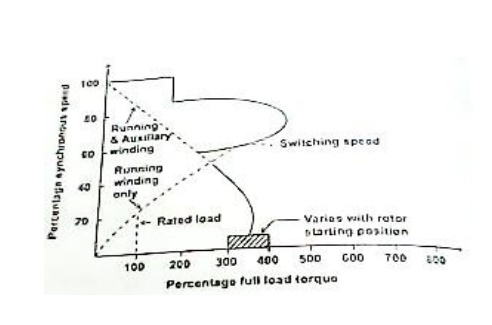Chapter: Special Electrical Machines : Synchronous Reluctance Motors
Torque - Speed Characteristics - Synchronous Reluctance Motor
TORQUE – SPEED CHARACTERISTICS
The
torque speed characteristic of synchronous reluctance motor is shown in fig.
The motor starts at anywhere from 300 to 400 percent of its full load torque
(depending on the rotor position of the unsymmetrical rotor with respect to the
field winding) as a two phase motor. As a result of the magnetic rotating field
created by a starting and running winding displaced 90° in both space and time.
At about
¾th of the synchronous speed a centrifugal switch opens the starting winding
and the motor continues to develop a single phase torque produced by its
running winding only. As it approaches synchronous speed, the reluctance torque
is sufficient to pull the rotor into synchronism with the pulsating single
phase field. The motor operates at constant speed up to a little over 20% of
its full load torque. If it is loaded beyond the value of pull out torque, it
will continue to operate as a single phase induction motor up to 500% of its
rated speed.

Application Characteristics:
v Comparable
power density but better efficiency than induction motor.
v Slightly
lower power factor than induction motor.
v Slightly
small field weakening range than induction motor.
v High cost
than induction motor but lower than any type of PM motors.
v Need
speed synchronization to inverter out frequency by rotor position sensor sensor
less control.
v Sensor
less control is much easier due to motor saliency.
v By adding
squirrel cage induction motor to synchronous reluctance motor one obtains line
starting reluctance moors.
v Line
started reluctance motors can be parallel with open loop control if the load
does not change suddenly.
v Other
combinations are possible such as adding PM for improved performance
v Rotor
design for best manufacturability is still being optimized especially for high
speed applications.
Related Topics